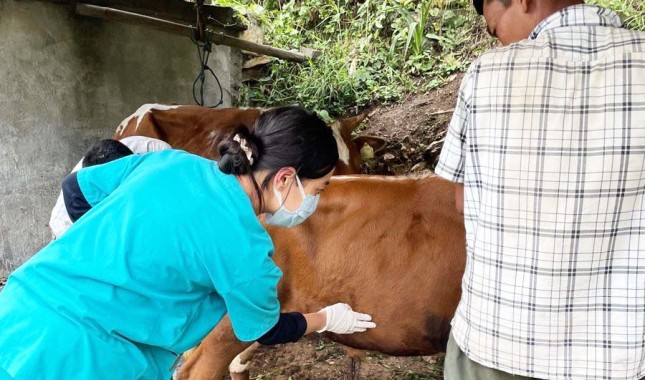




















Friday, Jul 07, 2023 08:45 [IST]
Last Update: Friday, Jul 07, 2023 03:06 [IST]
GANGTOK,: Lumpy Skin Disease has taken its toll on Sikkim's livestock population, with a confirmed report of 4,967 cases, according to Animal Husbandry & Veterinary Services secretary Dr. P Senthil Kumar.
As of July 1, there are 1,727 active cases in the State.
The distribution of active cases varies across different districts, with Namchi district leading the count at 848 cases. It is followed by Pakyong with 424 cases, Gangtok with 199, Soreng with 172, and Gyalshing with 77.
Mangan has the lowest number of active cases, also at 77.
The disease has so far claimed the lives of 323 animals, resulting in a death rate of 6.5%.
Dr. Kumar mentioned that the disease has infected around 3.2% of the total cattle population, which amounts to 148,934 livestock based on the 2019 livestock census.
Among the districts, Pakyong has experienced the highest mortality rate with 138 deaths, followed by Namchi with 118, Soreng with 38, Gangtok with 22, and Gyalshing with 9. Fortunately, Mangan has reported no livestock mortality.
In a relief measure for farmers and dairy producers, Chief Minister PS Golay has announced compensation for gwalas who lost their cattle.
Dr. Kumar assured that the department is actively working on the Chief Minister's directives, and a proposal is currently being prepared.
The outbreak of Lumpy Skin Disease was initially confirmed in Sikkim on December 12, 2022 in Pakyong and Namchi districts, gradually spreading to bovines in all districts. Responding promptly, the State implemented Standard Operating Procedures (SOP) on January 4 this year to contain the disease.
Due to the escalating number of cases in Pakyong and Namchi districts, the department declared them "Control areas" under the Prevention and Control of Infectious and Contagious Diseases in Animals Act, 2009, on January 9.
The State Animal Husbandry & Veterinary Services department has undertaken an extensive vaccination drive across all districts. As of July 1, 39.84% of the livestock population, amounting to 58,177 bovines, have been vaccinated.
Namchi district leads the vaccination efforts with 19,526 animals immunized, followed by Gangtok with 10,858. Pakyong, Gyalshing, Soreng, and Mangan districts have vaccinated 8,625, 7,757, 7,529, and 3,882 bovines, respectively.
Although there is no specific vaccine for Lumpy Skin Disease, the Central government has provided the goat pox vaccine, which shares similar characteristics and targets livestock diseases and provides cross immunity to the Lumpy Skin Disease. This vaccine has been successfully used to immunize bovines across the State.
Highlighting the importance of vector control measures and hygiene in affected areas, the Animal Husbandry & Veterinary Services secretary stressed the role of biting insects such as mosquitoes, flies and ticks in the transmission of the disease. He urged farmers to maintain cleanliness on their farms and minimize unnecessary movements in affected areas.
On a positive note, the recovery rate stands at 58%, with 1,294 cases in Namchi district, 564 in Soreng, 499 in Pakyong, 269 in Gyalshing, 176 in Gangtok, and 16 in Mangan district having fully recovered from the disease, as per the department's data.
In a bid to dispel misconceptions surrounding the spread of Lumpy Skin Disease to humans, Dr. Kumar reassured the public that the disease is restricted solely to bovines and poses no threat to human health. He emphasized that dairy products, including milk, are completely safe for human consumption.
Furthermore, the Animal Husbandry secretary urged farmers and dairy producers to promptly contact their local veterinary dispensaries if they observe any symptoms related to the disease. For those residing in areas without veterinary facilities, a dedicated helpline number (1962) has been made available to seek assistance and guidance.
In a proactive measure, the State has implemented a ban on the entry of cattle from other States since May 10. All veterinary institutions have been provided with all essential medicines for control and management of disease. The Animal Husbandry & Veterinary Services department has been consistently issuing advisories since the first reported case to raise awareness and ensure preventive measures are in place, it was informed.
